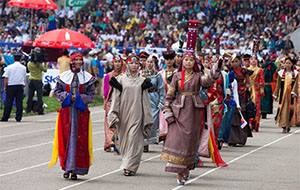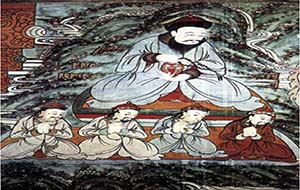

Playing the Morin khuur is accompanied with dances, long songs, mythical tales, ceremonies and everyday tasks related to horses.
The Morin khuur also accompanies Biyelgee, the body dance of hand, shoulder and legs movement. This dance originated in the Altai mountains in the west of Mongolia. Today Mongolians and Mongolian government is paying special attention to development and deepening interest of people in Morin Khuur. An example of this is 999 horse-head fiddle players who performed during Naadam. Also horse-head fiddle players’ assembly is now about in its 20th anniversary.
From ancient times the Mongolian people have used the horse for transportation and have given it an honored position in their everyday lives. For example, when a horse died, its head was placed on top of a mountain, rather than buried in the dirty ground. The horse's tail was carefully preserved to make strings for musical instruments, and the soft skin of the horses groin was used to cover the body of the “horse-head fiddle” instrument.
The design of the Morin khuur is closely linked to the all-important cult of the horse. The instrument’s hollow trapezoid-shaped body is attached to a long fretless neck bearing a carved horse head at its extremity. Just below the head, two tuning pegs jut out like ears from either side of the neck. The soundboard is covered with animal skin, and the strings and bow are made of horsehair. The instrument’s characteristic sound is produced by sliding or stroking the bow against the two strings. Common techniques include multiple stroking by the right hand and a variety of left-hand fingering. It is mainly played in solo fashion but sometimes accompanies dances, long songs (urtiin duu), mythical tales, ceremonies and everyday tasks related to horses. To this day, the Morin khuur repertory has retained some tunes (tatlaga) specifically intended to tame animals. Owing to the simultaneous presence of a main tone and overtones, Morin khuur music has always been difficult to transcribe using standard notation. It has been transmitted orally from master to apprentice for many generations. Over the past forty years, most Mongolians have settled in urban centres, far from the Morin khuur’s historical and spiritual context. Moreover, the tuning of the instrument is often adapted to the technical requirements of stage performance, resulting in higher and louder sounds that erase many timbral subtleties. Fortunately, surviving herding communities in southern Mongolia have managed to preserve many aspects of Morin khuur playing along with related rituals and customs.
There are several variants of the mythology explaining the origins of the instrument.
All the stories tell about the love of a man to his horse.
The dominant story tells about Sukhee who found a young horse besides his dying mother. Sukhee adopted the young foal and took good care of him. One day he took part in a horse race and to the dismay of the professional horsemen, Sukhe won the race, even the local governor, noted as an evil man, was defeated. That night Sukhee found his beloved horse dead, having been shot with arrows. In his grief his horse came to him in his dream. The horse "told" him to use its bones, skin and tail to create a musical instrument similar to a fiddle. In that way Sukhee and his horse could remain together. Sukhee did so and the instrument is said to have a sad sound.








































